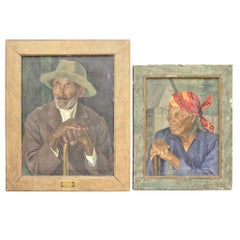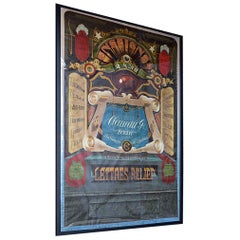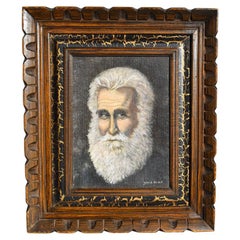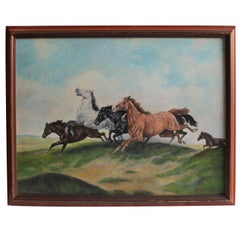Early 20th Century Paintings
1
194
to
23
130
60
194
194
194
35
17
9
2
2
2
1
118
297
1,455
270
194
592
486
12
5
25
23
20
53
87
97
51
51
92
89
46
46
40
45
38
36
13
11
2
1
1
1
1
Period: Early 20th Century
Pair of Vera Alabaster 'Russian' Original Folk Art Oil Paintings on Canvas
Located in Hamilton, Ontario
This pair of oil paintings on canvas are done by the well known portrait and landscape Russian artist, Vera Alabaster in circa 1940 in a Folk Art style. The paintings depict a Jamaic...
Category
Russian Folk Art Early 20th Century Paintings
Materials
Canvas
Exquisite Early 20th Century French Hand Lettering Trade Sign
Located in London, GB
We are proud to offer an exquisite early 20th century French hand lettering trade sign. This is truly a unique piece of trade sign retail art in our opi...
Category
French Victorian Vintage Early 20th Century Paintings
Materials
Canvas
Folk Art Still Life, 'Flowers and Chinese Export Porcelain', Early 20th Century
Located in Chappaqua, NY
Folk Art Still Life, 'Flowers and Chinese Export Porcelain', early 20th century. Oil on canvas with original lacquered frame. A charming painting of cut flowers with antique Chinese ...
Category
Folk Art Early 20th Century Paintings
Materials
Canvas, Wood
"The Hunter" Unsigned 20th Century Folk Art Oil Painting
Located in Los Angeles, CA
This painting is dated on the stretcher frame 1940 and the large over sized dog is a pointer or know as a bird dog. The birds are quail. This painting is amazing and very well done. ...
Category
American Adirondack Early 20th Century Paintings
Materials
Canvas, Paint
Framed Portrait Painting of a Man with Beard by American Artist Genie Brock
Located in Oklahoma City, OK
Vertical portrait painting of a man by American artist Genie Brock. (Oklahoma, circa early 20th century) The subject is of an older gentleman with a gray head of hair and beard. He s...
Category
American American Classical Early 20th Century Paintings
Materials
Canvas, Wood, Paint
Signed Oil Painting of Horses on Board
Located in Los Angeles, CA
This oil painting is signed in the lower left hand illegible signature. Very well done in great condition and retains the original frame.
Category
American Adirondack Early 20th Century Paintings
Antique Pair of Hand-Painted Earthenware Wall Plates Landscape with Deer / Stag
Located in Lisse, NL
Sizeable and decorative wall plates depicting wildlife in the mountains.
These are not your average, transfer printed wall plaques or plates. These sizeable plates each come with a ...
Category
German Early 20th Century Paintings
Materials
Earthenware
Frank Vincent DuMond Impressionist Painting
Located in Redding, CT
Frank Vincent DuMond painting. Bucolic setting of a woman in a pastoral scene by a river. She is seated reading and dressed in an Edwardian, early 20th century clothing. Signed lower left. "To My Friend Mr.Kempshall, Frank V. DuMond".
Frank Vincent DuMond was one of the most influential teacher-painters in 20th century America. He was an illustrator and American Impressionist painter of portraits and landscapes, and a prominent teacher who instructed thousands of art students throughout a career spanning over fifty years.
In a teaching career spanning more than fifty years, DuMond taught thousands of artists at the art students league. His students included Norman Rockwell, Georgia O'Keeffe, John Marin, Frank J. Reilly,Charles Webster Hawthorne,Frank Herbert Mason,Ogden Pleissner, Kenneth Hayes Miller, Louis Bouché, Eugene Speicher,Helen Winslow...
Category
French Romantic Early 20th Century Paintings
Materials
Wood, Canvas, Linen
"The Thunderbird" Original Oil Painting by Jack Weldon Humphrey
Located in Coeur d'Alene, ID
(1901-1967). Oil on canvas; 20" x 24". Very prominent Canadian painter. His works are included in most exhibitions of 20th century Canadian art with dozens of examples in permanent c...
Category
Canadian Vintage Early 20th Century Paintings
Materials
Paint
Cubist Still Life "Violin" by Agnes Weinrich, Signed, Dated 1922
By Agnes Weinrich
Located in New York, NY
Still life painting (Violin, Flowers), Oil on canvas, by Agnes Weinrich, Signed and dated "22", Unframed: 20" x 16", Framed 27.5 x 23".
Agnes Weinrich (1873-1946) was an early female, American modernist artist at a time when there was little interest in Modern Art in the USA and when few women were artists. She was a ground breaker in modern art. The painting shown is an important example of her mature phase of her work.
A biography from Wiki-pedia follows:
Agnes Weinrich (1873–1946) was one of the first American artists to make works of art that were modernist, abstract, and influenced by the Cubist style. She was also an energetic and effective proponent of modernist art in America, joining with like-minded others to promote experimentation as an alternative to the generally conservative art of their time.
Early years[edit]
Agnes Weinrich was born in 1873 on a prosperous farm in south east Iowa. Both her father and mother were German immigrants and German was the language spoken at home. Following her mother's death in 1879 she was raised by her father, Christian Weinrich. In 1894, at the age of 59, he retired from farming and moved his household, including his three youngest children—Christian Jr. (24), Agnes (21), and Lena (17), to nearby Burlington, Iowa, where Agnes attended the Burlington Collegiate Institute from which she graduated in 1897.[1][2][3] Christian took Agnes and Lena with him on a trip to Germany in 1899 to reestablish links with their German relatives. When he returned home later that year, he left the two women in Berlin with some of these relatives, and when, soon after his return, he died, they inherited sufficient wealth to live independently for the rest of their lives.
Either before or during their trip to Germany Lena had decided to become a musician and while in Berlin studied piano at the Stern Conservatory. On her part, Agnes had determined to be an artist and began studies toward that end at the same time.[1][4] In 1904 the two returned from Berlin and settled for two years in Springfield, Illinois, where Lena taught piano in public schools and Agnes painted in a rented studio. At this time Lena changed her name to Helen. In 1905 they moved to Chicago where Agnes studied at the School of the Art Institute of Chicago under John Vanderpoel, Nellie Walker, and others.[1]
In 1909 Agnes and Helen returned to Berlin and traveled from there to Munich, where Agnes studied briefly under Julius Exter, and on to Rome, Florence, and Venice before returning to Chicago.[5] They traveled to Europe for the third, and last, time in 1913, spending a year in Paris. There, they made friends with American artists and musicians who had gathered there around the local art scene. Throughout this period, the work Agnes produced was skillful but unoriginal—drawings, etching, and paintings in the dominant academic and impressionist styles.[1]
On her return from Europe in 1914, she continued to study art, during the warm months of the year in Provincetown, Massachusetts,[1] where she was a member of the Provincetown Printers art colony in Massachusetts,[6] and during the colder ones in New York City. In Provincetown she attended classes at Charles Hawthorne's Cape Cod School of Art and in New York, the Art Students League.[1]
Drawing of an old woman by Agnes Weinrich, graphite on paper, 11.5 x 7.5 inches.
Hawthorne and other artists established the Provincetown Art Association in 1914 and held the first of many juried exhibitions the following year. Weinrich contributed nine pictures to this show, all of them representational and somewhat conservative in style.[1]
A pencil sketch made about 1915 shows a figure, probably one of the Portuguese women of Provincetown. Weinrich was a metculous draftsperson and this drawing is typical of the work she did in the academic style between 1914 and 1920. She also produced works more akin to the Impressionist favored by Hawthorne and many of his students. When in 1917 Weinrich showed paintings in a New York women's club, the MacDowell Club, the art critic for the Brooklyn Daily Eagle said they showed a "strong note of impressionism."[7]
Broken Fence by Agnes Weinrich, a white-line woodblock made on or before 1917; at left: the woodblock itself; at right: a print pulled from the woodblook.
In 1916 Weinrich joined a group of printmakers which had begun using the white-line technique pioneered by Provincetown artist B.J.O. Nordfelt. She and the others in the group, including Blanche Lazzell, Ethel Mars and Edna Boies Hopkins, worked together, exchanging ideas and solving problems.[1][8] A year later Weinrich showed one of her first white-line prints at an exhibition held by the Pennsylvania Academy of Fine Arts in Philadelphia.[9]
Broken Fence, in its two states—the print and the woodblock from which she made it—show Weinrich to be moving away from realistic presentation, towards a style, which, while neither abstract, nor Cubist, brings the viewer's attention to the flat surface plane of the work with its juxtaposed shapes and blocks of contrasting colors.
Cows Grazing in the Dunes near Provincetown by Agnes Weinrich, white-line woodcut, 10 x 10 1/2 inches
When in 1920 the informal white-line printmakers' group organized its own exhibition, Weinrich showed a dozen works, including one called Cows Grazing in the Dunes near Provincetown. This print shows greater tendency to abstraction than eitherBroken Fence or the prints made by other Provincetown artists of the time. The cows and dunes are recognizable but not presented realistically. The white lines serve to emphasize the blocks of muted colors which are the print's main pictorial elements. Weinrich uses the texture of the wood surface to call attention to the two-dimensional plane—the paper on which she made the print—in contrast with the implicit depth of foreground and background of cows, dunes, and sky. While the work is not Cubist, it has a proto-Cubist feel in a way that is similar to some of the more abstract paintings of Paul Cézanne.[10]
By 1919 or 1920, while still spending winters in Manhattan and summers on Cape Cod, the sisters came to consider Provincetown their formal place of residence.[1][11][12][13] By that time they had also met the painter, Karl Knaths. Like themselves a Midwesterner of German origin who had grown up in a household where German was spoken, he settled in Provincetown in 1919. Agnes and Knaths shared artistic leanings and mutually influenced each other's increasing use of abstraction in their work.[1][14]
The sisters and Knaths became close companions. In 1922 Knaths married Helen and moved into the house which the sisters had rented. He was then 31, Helen 46, and Agnes 49 years old. When, two years later, the three decided to become year-round residents of Provincetown, Agnes and Helen used a part of their inheritance to buy land and materials for constructing a house and outbuildings for the three of them to share. Knaths himself acquired disused structures nearby as sources of lumber and, having once been employed as a set building for a theater company, he was able to build their new home.[15]
Weinrich was somewhat in advance of Knaths in adopting a modernist style. She had seen avant-garde art while in Paris and met American artists who had begun to appreciate it. On her return to the United States she continued to discuss new theories and techniques with artists in New York and Provincetown, some of whom she had met in Paris. This loosely-knit group influenced one another as their individual styles evolved. In addition to Blance Lazzell, already mentioned, the group included Maude Squires, William Zorach, Oliver Chaffee, and Ambrose Webster. Some of them, including Lazzell and Flora Schofield had studied with influential modernists in Paris and most had read and discussed the influential Cubist and Futurist writings of Albert Gleizes and Gino Severini.[16][17]
Mature style[edit]
Woman with Flowers by Agnes Weinrich, circa 1920, oil on canvas, 34 x 30 1/4 inches, exhibited at the Provincetown Art Association exhibition of 1920, made available courtesy of the Association.
Two of Weinrich's paintings, both produced about 1920, mark the emergence of her mature style. The first, Woman With Flowers, is similar to one by the French artist, Jean Metzinger called Le goûter (Tea Time) (1911).[18]
Red Houses by Agnes Weinrich, circa 1921, oil on canvas on board, 24.25 x 25.5 inches; exhibited "Red Houses" at Fifth Annual Exhibition of the Society of Independent Artists.
Like much of Metzinger's work, Le goûter was discussed in books and journals of the time—including one called Cubism co-authored by Metzinger himself.[19] Because the group with which Weinrich associated read about and discussed avant-garde art in general and Cubism in particular, it is reasonably likely that Weinrich was familiar with Metzinger's work before she began her own.
The second painting, Red Houses, bears general similarity to landscapes by Cézanne and Braque. Both paintings are Cubist in style. However, with them Weinrich did not announce an abrupt conversion to Cubism, but rather marked a turning toward greater experimentation. In her later work she would not adopt a single style or stylistic tendency, but would produce both representative pictures and ones that were entirely abstract, always showing a strong sense of the two-dimensional plane of the picture's surface. After she made these two paintings neither her subject matter nor the media she used would dramatically change. She continued to employ subjects available to her in her Provincetown studio and the surrounding area to produce still lifes, village and pastoral scenes, portraits, and abstractions in oil on canvas and board; watercolor, pastel, crayon and graphite on paper; and woodblock prints.[20]
Possessing an outgoing and engaging personality and an active, vigorous approach to life, Weinrich promoted her own work while also helping Karl Knaths to develop relationships with potential patrons, gallery owners, and people responsible for organizing exhibitions. With him, she put herself in the forefront of an informal movement toward experimentation in American art. Since, because of her independent means, she was not constrained to make her living by selling art, she was free to use exhibitions and her many contacts with artists and collectors to advance appreciation and understanding of works which did not conform to the still-conservative norm of the 1920s and 1930s.[1][21][22]
Early in the 1920s, critics began to take notice of her work, recognizing her departure from the realism then prevailing in galleries and exhibitions. Paintings that she showed in 1922 drew the somewhat dry characterization of "individualistic.",[23] and in 1923 her work drew praise from a critic as "abstract, but at the same time not without emotion."[24]
In 1925 Weinrich became a founding member of the New York Society of Women Artists. Other Provincetown members included Blanche Lazzell, Ellen Ravenscroft, Lucy L'Engle, and Marguerite Zorach. The membership was limited to 30 painters and sculptors all of whom could participate in the group's exhibitions, each getting the same space.[23][25][26] The group provided a platform for their members to distinguish themselves from the genteel and traditionalist art that women artists were at that time expected to show[27] and, by the account of a few critics, it appears their exhibitions achieved this goal.[1][28][29][30]
In 1926 Weinrich joined with Knaths and other local artists in a rebellion against the "traditional" group that had dominated the Provincetown Art Association. For the next decade, 1927 through 1937, the association would mount two separate annual exhibitions, the one conservative in orientation and the other experimental, or, as it was said, radical.[31][32] Both Weinrich and Knaths participated on the jury that selected works for the first modernist exhibition.[11]
Still Life by Agnes Weinrich, circa 1926, oil on canvas, 17 x 22 inches. Permission to use granted by Christine M. McCarthy, Executive Director, Provincetown Art Association and Museum. The painting was the gift of Warren Cresswell.
Weinrich's painting, Still Life, made about 1926, may have been shown in the 1927 show. Representative of some aspects of her mature style, it is modernist but does not show Cubist influence. The objects pictured are entirely recognizable, but treated abstractly. Although fore- and background are distinguishable, the objects, as colored forms, make an interesting and visually satisfying surface design.
In 1930 Weinrich put together a group show for modernists at the GRD Gallery in New York. The occasion was the first time a group of Provincetown artists exhibited together in New York. For it she selected works by Knaths, Charles Demuth, Oliver Chaffee, Margarite and William Zorach, Jack Tworkov, Janice Biala, Niles Spencer, E. Ambrose Webster, and others.[1][23]
Later years[edit]
Weinrich turned 60 on July 16, 1933. Although she had led a full and productive life devoted to development of her own art and to the advancement of modernism in art, she did not cease to work toward both objectives. She continued to work in oil on canvas and board, pastel and crayon on paper, and woodblock printing. Her output continued to vary in subject matter and treatment. For example, Still Life with Leaves, circa 1930 (oil on canvas, 18 x 24 inches) contains panels of contrasting colors with outlining similar to Knaths's style. Movement in C Minor, circa 1932 (oil on board, 9 x 12 inches) is entirely abstract. It too relates to Knaths's work, both in treatment (again, outlined panels of contrasting colors) and in its apparent relationship to music, something in which Knaths was also interested. Fish Shacks...
Category
American Modern Early 20th Century Paintings
Materials
Paint, Canvas
American Oil on Board Portrait of Horse, NY, James Weiland, Circa 1900
By James Weiland
Located in Hollywood, SC
American oil on board portrait of horse landscape in the original gold gilt floral frame. Signed James Weiland, (1872-1968) New York, Early 20th cent...
Category
American American Classical Early 20th Century Paintings
Materials
Wood, Paint
American Folk Art Painting Signed J.W. Fosdick 1903
Located in South Burlington, VT
American Folk Art Pyrography At Its Finest
This is an original and beautiful 23 inch by 19.25 inch hand-painted and hand incised work of art on board of a lovely Victorian lady enth...
Category
American Arts and Crafts Antique Early 20th Century Paintings
Materials
Wood
Interior, grandfather and child. Oil on canvas, unidentified artist. 1920s.
Located in Copenhagen, DK
Interior, grandfather and child. Oil on canvas, unidentified artist, indistinctly signed. 1920s. Framed in heavy wooden gilt frame. Dimensions 52x63 cm, dimensions with frame 72x84 cm.
Category
Unknown Early 20th Century Paintings
Pastel Signed and Dated 1929 Horse Head Profile
Located in Los Angeles, CA
Signed and dated by Datroll 1929 pastel water color on paper and in vintage original frame. The condition is very good.
Category
American Adirondack Vintage Early 20th Century Paintings
Oil on board, portrait of nude woman, indistinctly signed, unknown artist. 1920.
Located in Copenhagen, DK
Oil on board, portrait of nude woman, indistinctly signed, unknown artist. Approximately 1920. Measures 23x41 cm. The frame is 3 cm. wide.
Category
Unknown Early 20th Century Paintings
Christian Valdemar Clausen, Nude Woman at a Wooden Pier
Located in Copenhagen, DK
Christian Valdemar Clausen (1862-1911). Nude woman at a wooden pier. Oil on canvas. Signed in monogram 1906. Measures: 68 x 54 cm. (90 x 75 cm.) In good condition.
Category
Danish Early 20th Century Paintings
Oil on paper, abstract composition approx. 1920s. Signed illegible.
Located in Copenhagen, DK
Oil on paper, abstract composition approx. 1920s. Signed illegible. In good condition. Measures: 28 x 24 cm (visible size).
Category
Unknown Early 20th Century Paintings
20th Century Oil on Canvas French Grisaille Painting Cherubs, 1920
Located in Vicoforte, Piedmont
French painting from the first half of the 20th century. Artwork oil on canvas depicting cherubs with grisaille style garland, of good pictorial quality. Painting adorned with a wood...
Category
French Vintage Early 20th Century Paintings
Materials
Canvas
Antique Clipper Ship Model
Located in Norwell, MA
Early Twentieth Century ship model of an American windjammer. Awesome cabin and deck work with varnish finish. Fully rigged with all appropriate cords. Take a look at the quality woo...
Category
North American Vintage Early 20th Century Paintings
Materials
Wood
1920s William Bradford Green Watercolor with Heydendryk Frame
Located in Miami, FL
Dramatic and lovely watercolor happy depiction of a period 1920s lady at an open window looking out at the follage and potted plants. Realized by William Bradford Green...
Category
American Art Deco Vintage Early 20th Century Paintings
Materials
Silk, Glass, Wood, Paint, Paper
Recently Viewed
View AllMore Ways To Browse
Antique Corner Cabinet With Glass Doors
Chest Of Drawers With Black Marble Top
Breakfast Room Chairs
Carver Chair Antique Furniture
Mid Century Armless Chair
Midcentury Armless Chair
Luxury Dining Chair
Dining Chairs With Red Leather
Danish Dining Chairs Set 8
Antique Dressers And Commodes
Dutch Inlaid
Large Swedish Gustavian
Hand Carved Wooden Panel
Upholstered Dining Chair Brass Legs
Arched Door Pairs
Midcentury Danish Modern Wall Unit
Mid Century Danish Modern Wall Unit
Armless Mid Century Chair





